Save On Potting Soil By Knowing When To Refresh Vs When To Replace
Do you pull your pots out of the shed in spring only to find yourself wondering, "How am I going to fill all of these?" You're not alone. Even Martha Stewart uses bubble wrap in her potted plants to help take up space. However, if your pots are still filled with last year's soil, you might be wondering if you save yourself some time and money by reusing it. Yes, you can, but not in every case.
Container gardeners know that sometimes you can pull a plant out of a pot with ease, leaving nothing more than a small hole where the plant used to be. If that's the case, then your soil is probably fine to be refreshed. Other times, you try to pull out a plant and it brings most of the soil with it in one big tangle of roots. This won't be reusable. Any signs of pest or disease are also a red flag that soil is a lost cause, so it's important to dig through the material to get a better idea of exactly what you're working with.
When and how to refresh your potting soil
If last year's plants died at the end of their lifecycle and not from pests or disease, you can probably reuse your old potting soil. There are a few things you need to know. First, it will likely be more compacted than fresh, new potting soil. It will also be depleted of the nutrients that manufacturers add. You will need to address both of these potential problems for your plants. Plan to give your soil a fluff, loosening it and adding air pockets back into the soil to aid in drainage. Additionally, you will need to amend the soil with a slow release fertilizer to help feed your plants. Or, you can address both issues in one fell swoop by dumping out all of your old soil and mixing it with new soil.
Alternatively, you can remove the top 6 inches of soil from your pots and replace it with fresh, new soil. This will cut down on the amount of new soil you need to buy while still giving your plants a fresh start. If your soil is compacted enough, you may not even need to remove old soil — simply add new material on top.
It's also worth noting that poor soil quality is no problem for some plants. Reused potting soil may be just what these plants need. Mediterranean herbs, for example, love dry soil without a lot of nutrients, so they will likely thrive in old soil with very little need for amendment.
When to replace your potting soil
If you want to reuse soil in your garden, you will need to assess the soil's condition. If you get it wrong and use soil that is too far gone, you can end up costing yourself more money by killing plants, so be realistic and replace the soil that is no longer usable. If your soil is filled with roots, you'll know it's time to move on. However, the most important thing to know is that if the plants you had in that soil developed any diseases or other issues with weeds or bugs, it should not be reused. Those issues signal that it's time to start new. In fact, it's a good idea to dump that soil at the end of the season so you aren't tempted to recycle it.
There are ways to sterilize diseased soil, but for the average gardener, solarizing or even baking soil is probably not going to be an option. Instead, focus on new, high-quality soil, and use tips and tricks like TikTok's viral pool noodle hack for saving soil in large pots. Try to keep your plants healthy this year, and you'll be rewarded with the ability to reuse the soil next season.


